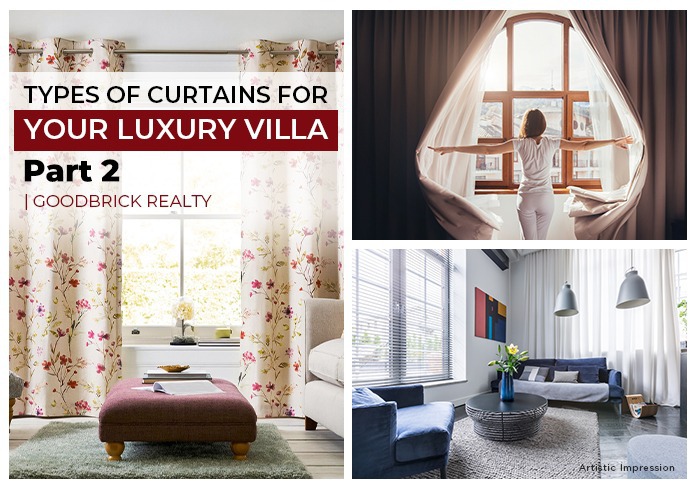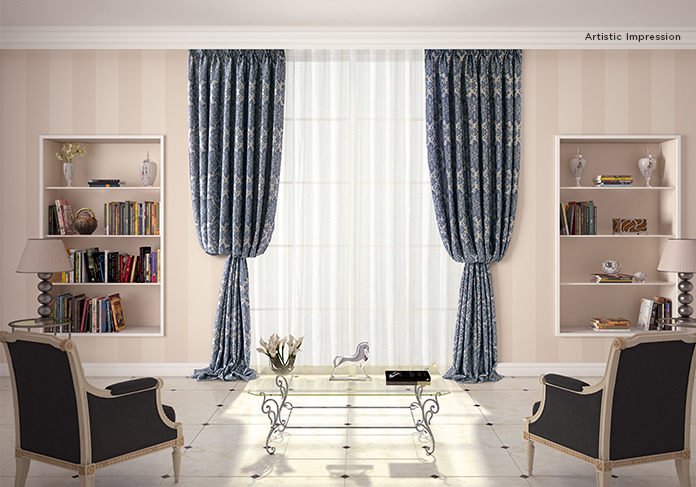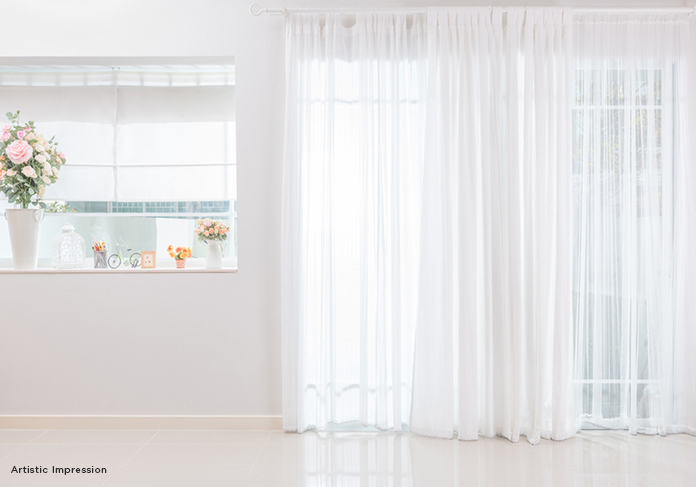
Are you ready to discover the curtain secrets that will turn your dream residence into a haven of style, comfort, and elegance? Welcome to Part 2 of our blog series on ‘Types of Curtains for Your Dream Residence.’
In this part, we will delve even deeper into the realm of window dressings, unveiling a captivating array of curtain fabrics, and styles that will leave you inspired and ready to transform your living space.
So, let’s embark on a journey where simplicity meets sophistication and the perfect curtain becomes the crowning jewel of your dream abode.
When it comes to choosing the right type of curtain, one crucial aspect to consider is the fabric it is made of. The material of the curtain serves more than just a decorative purpose.
Thinner fabrics are utilised to craft sheer or semi-sheer curtains, whereas thicker fabrics are employed for semi-opaque and blackout curtains. Additionally, different curtain materials may offer extra features to enhance their functionality.
When transforming a villa for sale in Lonavala into your dream abode, selecting the perfect curtains becomes essential to enhancing both the aesthetic appeal and functionality of your luxurious living space.
Let’s explore some of the most popular choices that can add a touch of elegance and style to your living space:

Luxurious and opulent, velvet curtains exude a sense of grandeur. Their plush texture and rich colours make them a perfect choice for adding drama and sophistication to any room.
If you prefer maximum privacy, this fabric stands out above the rest. With its weighty composition, it not only provides a high level of privacy but also acts as a barrier against drafts and minimises external noise.
Known for their smoothness and natural lustre, these types of curtains bring an air of refinement to your home. They gracefully drape and reflect light, creating a visually stunning effect that is both timeless and captivating.
It is a popular fabric in contemporary and classic curtain styles. When it comes to silk curtains, it’s important to note that they require professional cleaning. Therefore, it’s essential to take into account the associated upkeep costs before making a decision to invest in silk curtains for your villa in Khandala.
If you’re seeking a more rustic and organic look, burlap curtains are the way to go. Their coarse yet charming texture adds a touch of warmth and earthiness to your decor, making them ideal for a cosy and relaxed ambience.
Cleaning burlap curtains is easy, making them a practical choice. Not only that, but these types of curtains also add a charming touch to more relaxed and informal settings.
Delicate and romantic, lace curtains bring a sense of nostalgia and charm to any space. Their intricate patterns and sheer elegance allow diffused light to filter through, creating a soft and dreamy atmosphere.
Lace curtains are suitable in kitchens, living rooms, and other areas where an abundance of natural light is desired. They allow ample light to filter through, creating a bright and airy atmosphere. Moreover, lace curtains can be combined with heavier fabrics, offering a flexible window treatment option that suits various styles and preferences.
Versatile and widely loved, cotton curtains offer a classic and casual aesthetic. With their natural fibres and breathable quality, they provide a light and airy feel, perfect for brightening up your home.
Cotton curtains come in a wide range of styles, making them a suitable option for any room in your home. The fact that they are simple to clean adds to their practicality and convenience while also increasing their versatility.
If you’re aiming for a chic and effortless look, linen curtains are an excellent choice. With their relaxed and slightly wrinkled appearance, they bring a sense of natural elegance and understated beauty to any room.
When it comes to cleaning, linen curtains require a bit more effort compared to cotton. Therefore, if you reside in a dusty environment, it’s worth considering that the rough texture of linen may attract and hold onto dust particles more readily. As a result, linen might not be the optimal choice for such environments.
When it comes to durability and practicality, synthetic fabrics like polyester or nylon curtains shine. They offer easy maintenance, resistance to fading, and a wide range of colours and patterns, making them a practical and stylish option for everyday living.
Synthetic fabrics can easily replicate the appearance and texture of any natural fabric, providing an economical alternative. They are more budget-friendly than natural fabrics, making them a sensible option for those concerned about the cost. If you’re searching for an effortless and practical window treatment, synthetic curtains may just be the perfect fit for you.
Remember, the fabric you choose for your curtains can significantly impact the overall look and feel of your dream residence. So, explore these options, consider your personal style and needs, and select the perfect fabric that reflects your unique taste and enhances the beauty of your home.
As we move forward in selecting the ideal curtains for your home, the next aspect to ponder is the curtain pattern.
Opting for solid curtains provides an excellent opportunity to complement and highlight other colours or patterns in your window treatments. Not only do they achieve a sleek and contemporary appearance, but they are also preferred across various curtain styles, particularly modern and casual designs.
Patterned curtains are highly sought-after across all styles of window treatments. They offer a wonderful opportunity to showcase your personality and achieve a specific look with your curtains.
Typically, patterned curtains are crafted from materials such as cotton, lace, or synthetic fabrics. However, you’ll also come across patterned curtains available in linen, burlap, or even embossed velvet varieties.
When it comes to popular patterns for window treatments, the options are vast. In both classic and contemporary curtains, you’ll often find patterns like floral motifs, stripes, checks, plaid, toile, and paisley.
On the other hand, casual curtains tend to feature a more relaxed interpretation of these classic patterns. Additionally, they may incorporate patterns such as chevrons, dots, geometric shapes, or graphic prints, adding a contemporary twist to the overall design.
The opacity of your curtains is another important factor to consider. Choosing the right level of opacity depends on the specific requirements of each room and its intended purpose.
For instance, in the bedroom, where blocking out sunlight is essential, you may prefer curtains with greater opacity rather than light silk or white curtain styles.
Determining the ideal opacity is undeniably a significant aspect of selecting curtains that perfectly meet your needs.
When it comes to opacity, curtains can be categorised into three main types, each offering unique benefits and serving different purposes. Let’s explore these categories:

Remember to consider the intended purpose of each room and your specific needs when selecting the opacity level of curtains. By understanding these three categories, you can make an informed decision to create the perfect balance of natural light, privacy, and ambience for your dream residence.
Let’s delve into the essential features to consider when selecting curtains, focusing on outdoor curtains, noise reduction, and insulation. Here’s what you need to know:
Outdoor curtains are specifically designed to withstand various weather conditions and provide privacy and shade in outdoor spaces. They are typically made from durable materials that are resistant to fading, moisture, and mildew.
With their ability to block out sunlight and create a cosy atmosphere, outdoor curtains can transform your patio, balcony, or deck into a comfortable and stylish outdoor retreat.
If you live in a bustling neighbourhood or near a busy street, noise-reducing curtains can make a significant difference in creating a tranquil and peaceful indoor environment. These curtains are crafted with special materials that absorb sound vibrations.
They help to minimise outside noise, allowing you to enjoy a quieter and more serene living space. Whether it’s the honking of cars or the clamour of construction, noise-reducing curtains work effectively to create a more peaceful ambience.
Insulating curtains provide an extra layer of thermal protection for your home by preventing heat loss during colder months and minimising heat gain in warmer seasons. These curtains are typically made from thick, heavyweight fabrics that act as a barrier against temperature fluctuations.
By effectively insulating your windows, these curtains help to reduce energy costs by maintaining a comfortable indoor temperature. Additionally, insulating curtains can also block out unwanted light, provide privacy, and enhance the overall aesthetic of your living space.
By considering these curtain features, you can make an informed decision based on your specific needs and create an inviting and comfortable environment in your dream residence
Choosing the right curtains for your dream residence can have a significant impact on both the aesthetics and functionality of your space. By considering factors such as fabric type, opacity, patterns, and additional features, you can create a window treatment that perfectly suits your style and needs.
Whether you prefer the elegance of silk, the versatility of cotton, or the cosiness of blackout curtains, there are a wide variety of options available to enhance your home. So, take your time, explore different styles, and let your curtains become the finishing touch that adds charm and comfort to your dream residence.
When it comes to curtain materials, the majority are made of fabrics like cotton and polyester. Some curtains may also incorporate cellulose materials such as wood or bamboo, or even plastic panels. The colour of the curtains can vary depending on the type of fibre used and the weave of the fabric. Curtains with a tight weave are more effective at blocking light from passing through. To create a darker atmosphere within a room, additional features like lining, backing, or specific colours may be added to obscure interior figures and objects without dimming the overall ambient light.
Curtains have varying lifespans depending on their use and exposure. Sunlight, especially the ultraviolet component, can speed up the ageing process of curtain materials, whether they are made of fabric, plastic, or cellulose.
Curtains hung in front of windows tend to age faster due to the direct sunlight they receive. Additionally, if there are heat registers or radiators near the windows, it can further contribute to the deterioration caused by UV exposure.
Open windows can allow rain and humidity to penetrate the curtains and the interior space, while bugs can find their way inside through windows or other openings. While modern fabrics are resistant to insects, curtains made from plant-based fibres are more susceptible to damage.
Curtains and draperies generally have a recommended lifespan of three to five years. However, adding a simple drapery lining can extend their longevity by 25%.
Curtains can be recycled, but it’s essential to check if it’s feasible in your area. Fabric fibre is valuable and can be used to create new products. You can inquire with local waste management companies to handle the disposal of curtain material or donate them to charities for resale. Some charities have fibre recycling programs that raise funds for their cause.
Yes, curtains can be dyed, but it is not advisable as the minimum life expectancy of curtains is less than five years, and dyeing can be damaging to the fabric. The colour outcome is also unpredictable as some colours and materials do not mix well. Although darker colours may cover lighter ones, managing the colour is not a straightforward process.
Curtains can be washed in a washing machine, but it’s crucial to read the label and adjust the machine settings accordingly. Take a moment to review the curtain label for specific cleaning instructions. In general, using the “delicate” cycle with cool water and a slow spin is suitable for light cleaning. However, it’s best to avoid using a dryer for drying curtains.
Maintaining curtains is easy! With simple cleaning and regular care, they stay in great condition.
Absolutely! White blackout curtains are just as effective as black blackout curtains. The color of the blackout curtains doesn’t affect their functionality—they all serve the same purpose. Blackout curtains are typically made from polyester or a polyester blend, which naturally blocks elements like wind, cold, and heat.
Yes, certain curtains are designed to minimise noise and create a more peaceful environment. Depending on the type of curtains you choose, they can absorb and reduce sound. Thermal back curtains, known for their thickness and weight, not only help regulate temperature but also act as a barrier to outside noise. These curtains effectively keep heat and cold air inside, making them energy-efficient.
The right curtains can limit vibrations caused by unwanted sounds, reducing overall noise levels. Curtains with a high fibre content (more threads per square inch or multiple layers) or made with heavy reflective materials (such as metal foils or threads) absorb or reflect sound vibrations, thereby reducing ambient noise from external sources. With noise reduction capabilities, these curtains offer both tranquillity and energy efficiency, making them an excellent addition to any space.
Yes, curtains can be repaired. In case of minor damages like loose threads or small tears, you can fix them easily with a needle and thread or fabric glue. For more significant repairs or complex issues, it’s recommended to seek the assistance of a professional tailor or curtain repair service. With proper care and attention, curtains can often be repaired, allowing you to extend their lifespan and continue enjoying them in your space.
Yes, curtains can help keep the cold out and maintain a warmer environment inside your space. Thicker and heavier curtains, such as thermal or insulated curtains, are particularly effective in insulating against the cold. When properly closed, they create a barrier that helps to prevent drafts and keep the cold air from seeping into the room. Additionally, curtains act as an extra layer of insulation, reducing heat loss through windows and helping to maintain a cosy and comfortable atmosphere during colder seasons.
Curtains can help save energy in your home. By properly closing them, especially during extreme weather conditions, you can reduce heat loss during winter and minimise heat gain during summer. This means your heating and cooling systems won’t have to work as hard to maintain a comfortable temperature, resulting in energy savings. Additionally, thicker and insulating curtains provide an extra layer of insulation, preventing drafts and reducing the need for artificial heating or cooling. By effectively managing the temperature in your space, curtains contribute to energy efficiency and can help lower your energy bills.
Yes, curtains are typically sold in pairs. This allows for a complete window treatment for a uniform look and proper coverage. However, it’s always best to double-check the product description or packaging to ensure that you are getting a pair and not a single panel.